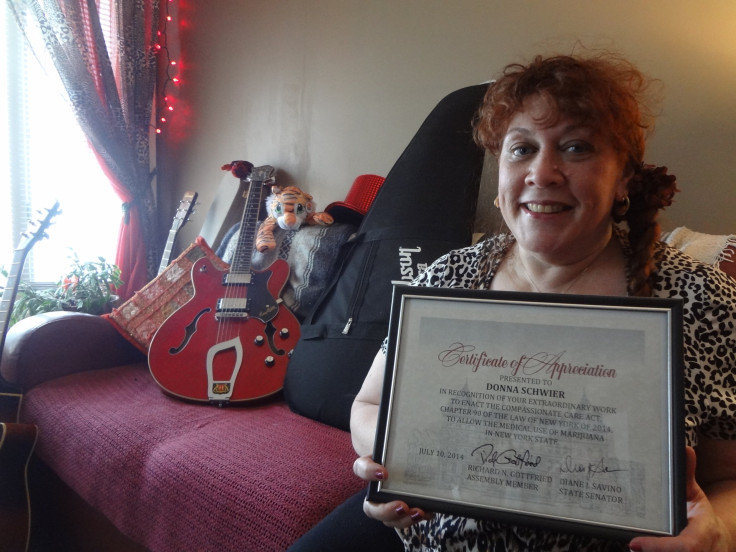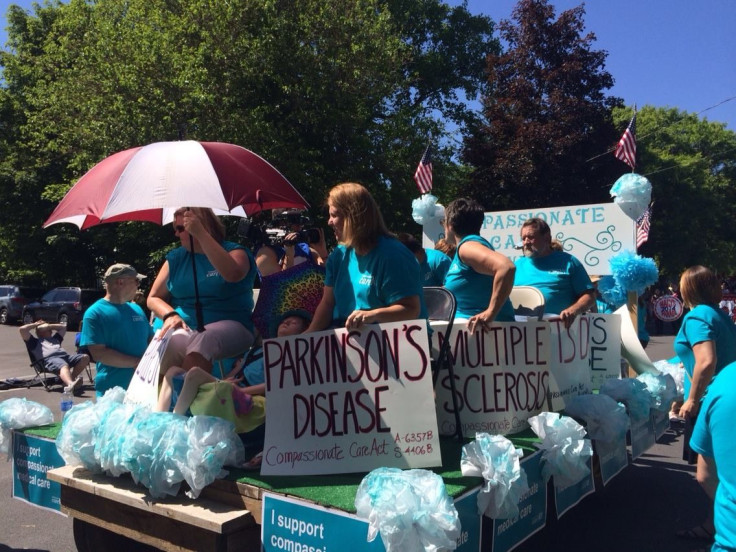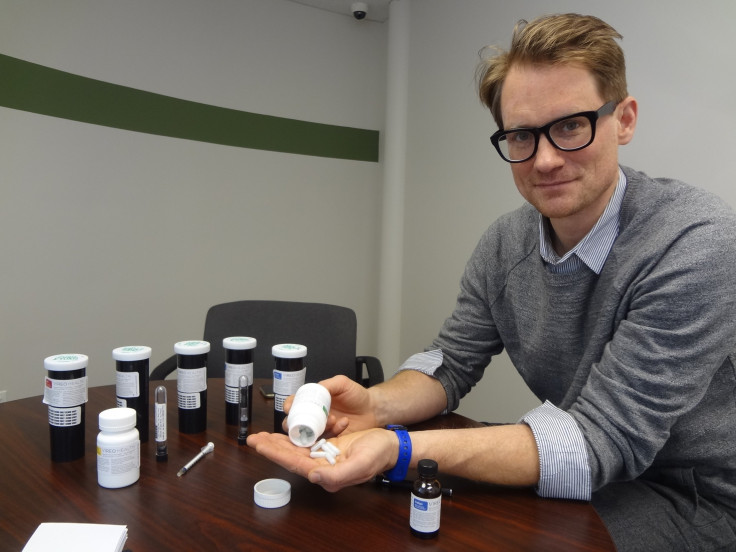Medical Marijuana In New York State: Patient-Advocates Who Built The Program Are Fighting To Access It

MEDFORD, New York — Grimacing, Donna Schwier rubs her left calf and looks out the window of her small basement-level apartment, tucked around the back of a suburban Long Island home. Outside, tree limbs are sagging under heavy new-fallen snow. That’s a concern, since cold and moisture exacerbate the fibromyalgia that has robbed Schwier of her career, her income and her identity.
“Today’s a reasonable pain day,” she says. “I am fresh out of opiates, though.”
The 60 hydrocodone pills she gets each month for the pain are supposed to be enough, but sometimes she can’t help but take more than her allotted two a day. So now she has to wait, pill-free, until she receives her February supply. Thankfully, the 58-year-old has another option, one she’s baked into cookies, that should get her through the dry period — although she doesn’t like to talk about it all that much. That’s because the cannabis she takes isn’t sanctioned in the eyes of the law, since she’s not an official medical marijuana patient.
That’s likely to change soon.

In January, all eyes were on New York state as it launched its medical marijuana program, meaning legal cannabis had finally arrived in the nation’s financial center. Schwier can take some credit for that; she was among the handful of patient-advocates who spent years lobbying state lawmakers to pass a medical marijuana bill, finally succeeding in 2014.
“I like to call myself an activist,” says Schwier, her big, expressive blue eyes flashing. “It implies action. It’s what I have done.”
But Schwier’s activism didn’t end in 2014. She’s still working to convince her doctor to jump through various legal hurdles so he can recommend medical marijuana for her. Even once she obtains her medical marijuana card, Schwier aims to keep lobbying on behalf of the thousands of potential New York medical marijuana patients who can’t access the program at all, thanks to the limited number of qualifying medical conditions and paltry number of dispensaries allowed statewide.
New York, a global center of business and finance, has unveiled a medical cannabis regime so hamstrung by rules that some people are worried it might not survive. A month into the effort’s launch, only 378 of the state’s 79,000 active physicians have registered to participate in the program, and of the 500,000 or so patients across the state who are believed to qualify, as of this week, fewer than 1,000 have been certified to do so by their doctors.
“New York’s rollout has gone probably as quickly as you can expect such a restricted program to move,” says New York Assemblyman Richard N. Gottfried, a Democrat from the New York City borough of Manhattan who’s long been a champion of medical marijuana. “But it’s a very limited program that is not reaching more than a few hundred patients, when it should be reaching tens of thousands of patients. I think if the restrictions imposed by the government and health department continue to hold the program back so seriously, it could certainly implode.”
The situation highlights a growing challenge nationwide as a booming cannabis industry eager for new markets confronts the increasingly stringent medical cannabis rules being adopted in states along the East Coast and elsewhere: How can medical marijuana programs thrive when they’re dependent on the continuing advocacy work of seriously ill patients like Schwier who are most in need of medicine?
Schwier's pain began in 2007 as a dull ache that radiated up her legs. Her doctor prescribed Vicodin, but the pills made her woozy and constipated, plus the symptoms worsened. By the time she was diagnosed with fibromyalgia, or chronic widespread pain, the agony was unbearable.
“From my neck down to my toes and the tips of my fingers was all a ball of severe pain,” she says. “I could not move.”
On top of that, she developed severe irritable bowel syndrome, leading to debilitating nausea and vomiting. She had to stop working, leaving the nursing job she’d enjoyed so much, since she loved helping people. She could no longer afford her Long Island apartment, so she moved into her cousin’s basement for eight months until her disability benefits came through. “I didn’t know where I was going to live. I didn’t know what was going to happen with my career. I didn’t know what I was going to do at all,” she says.
Eventually, she found her current apartment. It's a tiny space, but she has made it warm and cozy thanks to an abundance of draperies and throw pillows, plus her collection of guitars and two talkative parrots.
She tried other narcotics besides Vicodin, worked with pain management specialists and eventually had her left knee surgically replaced. But none of it seemed to really work.
One option did help: the cannabis she began consuming in 2010. A self-described “old hippie,” she’d smoked marijuana in the past, but not for medical reasons. Now she found eating small amounts of edibles throughout the day kept her pain at bay, and smoking a joint staved off the waves of nausea. “It helps relax all your muscles, it improves your mood, and it makes everything a little more tolerable,” she says.
It’s why when she heard in 2012 about Compassionate Care NY, an advocacy group working to legalize medical marijuana in the state, she joined the cause. The effort gave her something to believe in and something to work for. “I grabbed myself and said, ‘You have to live; you are going to be 440 pounds and lying in bed.’ So I chose to live,” she says. “When I found out about Compassionate Care, I had a calling.”
That calling wouldn’t be easy. New York’s lawmakers have long been conservative on drug issues. In the 1970s, New York passed the Rockefeller Drug Laws, stringent mandatory-minimum rules that stayed on the books for decades. And while polls repeatedly showed a majority of New Yorkers support legalizing medical marijuana, laws to do so proposed by Gottfried and others had gone nowhere year after year.
Schwier and her Compassionate Care colleagues — patients struggling through cancer, multiple sclerosis and other serious ailments — set about changing that. They launched pro-medical-marijuana postcard campaigns. They’d drive up to Albany, three hours from New York, and trek down the capital’s long, inhospitable halls, aiming to disabuse lawmakers of their “gateway drug” misconceptions through face-to-face meetings. And when they learned that one particularly reticent senator was going to be appearing at a small-town parade, they decided to march in the event themselves, arranging it so the lawmaker couldn’t help but notice their signs and cheers.

By the end of a typical lobbying day in Albany, Schwier could barely walk. But that didn’t stop her. “There are so many people who aren’t able to do this, so many who can’t do it,” she says. “It hurts, but I can do it. I am disabled, but I can still do something great.”
As the 2014 legislative session drew to a close, a medical marijuana bill appeared on the verge of passing. But then some disheartening news came from Gov. Andrew Cuomo’s office. If the bill, which would become known as the Compassionate Care Act, was going to avoid his veto, it would have to be significantly narrowed: Only 20 dispensaries allowed statewide, with only 10 conditions that could qualify for the program. No smokable or edible marijuana. No immediate emergency access to cannabis for those patients who need it most.
Schwier and her fellow activists struggled with whether to accept the compromise. “On the one hand, it was restrictive and going to leave some patients behind. On the other hand, there were many patients it would help,” says Julie Netherland, New York deputy state director for the Drug Policy Alliance, who works closely with the advocacy group. “The group’s decision was, it was better to try to get something in and help some patients now than to walk away with nothing. At the time, we had hoped it would help several thousand, even tens of thousands of New Yorkers. As it happened, that is looking less likely.”
These days, dispensaries such as the one run by Vireo Health of New York in the borough of Queens, which opened along a busy boulevard Jan. 22, can be proudly, almost defiantly, bland. Inside the center, which is open three days a week by appointment only, there are no glossy product advertisements or blown-up images of marijuana buds on its antiseptic white walls. Patients are buzzed through a security door after flashing their medical marijuana card and another form of ID, and then ushered into a unremarkable consulting room where an employee goes through Vireo’s offerings: pills, oil-filled syringes and vaporizer pens, each featuring one of the five strain makeups — “Indigo,” “Blue,” “Green,” “Yellow” and “Red” — that the operation is allowed to offer. Patients then move to a vending counter, no display cases in sight, where they pay in cash and receive their selection, which has to be retrieved from an 8-inch-thick steel safe in a backroom that looks like something out of a heist movie.
It’s all about presenting marijuana as medicine, says Stephen Dahmer, a family doctor who became chief medical officer for Vireo, which won one of the five state licenses to produce and dispense cannabis and has two other locations open around the state. “You are not going to see pot brownies here,” he says. “You will see pharmaceutical-grade medications. Vireo is physician-led, patient-driven.”
Still, Dahmer concedes some of the rules Vireo has to follow might be a bit much. And it’s hard to receive all those phone calls from potential patients wanting to know why they can’t be part of the program. “There are so many dichotomies here that don’t make sense,” he says. “But as a physician, you remove the word ‘frustration’ from your vocabulary.”

Others are willing to openly vent their frustrations. Firstly, there’s the limited number of patients who qualify for the program. While the law required Health Commissioner Howard Zucker to consider adding five more conditions, including post-traumatic stress disorder, Alzheimer’s disease and rheumatoid arthritis within 18 months of the bill’s signing, right before the program launched in January the commissioner declined to include any of them.
Even patients with ailments that qualify — such as cancer, HIV/AIDS, multiple sclerosis, epilepsy and neuropathy — are having trouble accessing the program. Their doctors have to complete a $249 online training program before recommending patients for medical marijuana. If their doctors aren’t willing to do so, it’s difficult for patients to find physicians who are, since the list of 350 physicians statewide certified for the program hasn't been made public.
Once a patient obtains a medical marijuana card, challenges remain. Only 20 dispensaries, divvied up between the five license holders, are allowed within New York’s 55,000 square miles, meaning many people have to drive hours to obtain medicine, which at this point doesn’t come cheap. The state's Department of Health declined to create a charity program to help offset the costs of medical marijuana, prices for which are set by the health commissioner. That means it’s up to the dispensaries to offer discounts, and with only five licensed companies in the state, there’s little competitive incentive to do so. While Dahmer says Vireo offers a 10 percent markdown to low-income clients, and the average cost to the company’s clients is about $300 a month, Netherland at the Drug Policy Alliance says she knows of a family in western New York that is facing spending $2,000 a month on cannabis oil for their child. That's more than the middle-class family spends on its mortgage.
Efforts are afoot to address these issues. Gottfried, the state lawmaker, recently proposed legislation to double the number of medical marijuana business licenses distributed by the state, part of a slate of bills he hopes to introduce in the coming weeks to expand the program. But in the meantime, some worry the damage has already been done. “I work with a group of 25 patient-leaders,” Netherland says. “They are the most informed patients in the state, and none of them has gotten medicine yet. And we are hearing about more and more people giving up and purchasing medicine on the illegal market.”
The situation could also be bad news for the various New York entrepreneurs eager to take advantage of the new industry. Already there are local vape pen companies positioning themselves to take advantage of the state’s smokable-cannabis moratorium, services that promise to connect patients with certified doctors, even local trade associations. But will these endeavors survive with an anemic patient market numbering only in the hundreds?
“I am not concerned about the patient number at all,” says Jeanine Moss, co-CEO of AnnaBís, a New Jersey-based line of fashion accessories that feature discreet, odor-proof marijuana storage compartments. “New York starts with its restrictive law, and AnnaBís starts with select designs. The plan is to learn and grow with our customers. Let’s intersect with the market now, let’s lay our plans, let’s introduce our products, let’s learn from the marketplace. This is going to be a gigantic market once everything gets sorted out.”
On a recent Friday, Schwier happily attended the opening ceremony of Columbia Care, a dispensary in Riverhead, about 20 miles from her apartment. She helped guarantee its launch; last year, she was among those who organized public opposition to a marijuana moratorium in Riverhead that would have prohibited the business from opening.
“When I started with Compassionate Care, our bill didn’t even reach the Senate floor,” she says, shaking her head. “Now it is 2016, and I am standing in my own dispensary.”
Still, she’s not yet allowed to patronize that dispensary because she doesn’t have her medical marijuana card, even though her fibromyalgia qualifies as a kind of neuropathic pain. With all her pestering, she is optimistic her doctor will soon take the online training course and recommend her for the program. But just to be safe, she’s planted a seed with her gastroenterologist, too. If those options don’t pan out, there are the medical marijuana doctor referral services springing up, although Schwier has reservations about them. “On the one hand, I know people need help,” she says. “On the other hand, this doctor doesn’t know you, and as a nurse, I believe in continuity of care and having a relationship with your doctor.”
In other words, Schwier’s fight isn’t over, just like those who worked so hard to pass the Compassionate Care Act still need to ensure it lives up to its name. “I have been so moved and impressed by what the patient advocates have been able to do, especially when so many of them were facing so many debilitating conditions,” Netherland says. “It gives me confidence that we will win this next phase of the fight. If it wasn’t for the advocates, I would be much more pessimistic than I am.”
Schwier is hopeful about plans to organize new postcard campaigns and Albany lobbying trips to support Gottfried’s legislative fixes to the medical marijuana program. That’s because her advocacy work provided her a goal in life when she most needed one; it gave her a way to help people again, just like she did as a nurse. Maybe, in some ways, her fight to legalize medical marijuana has helped her just as much as the medicine itself.
“I think this whole activism thing has really done well for me,” she says. “It has changed me for the better.”
She’ll likely continue to change. As Schwier notes with a smile, “I am not yet done.”
© Copyright IBTimes 2024. All rights reserved.





















